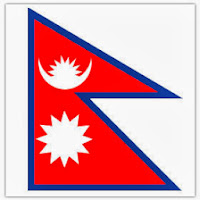Background
 |
| National Flag of Nepal |
 |
| Map of Nepal |
In 1951, the Nepali monarch ended the century-old system of rule by hereditary premiers and instituted a cabinet system of government. Reforms in 1990 established a multiparty democracy within the framework of a constitutional monarchy. An insurgency led by Maoist extremists broke out in 1996. The ensuing 10-year civil war between insurgents and government forces witnessed the dissolution of the cabinet and parliament and assumption of absolute power by the king. Several weeks of mass protests in April 2006 were followed by several months of peace negotiations between the Maoists and government officials, and culminated in a November 2006 peace accord and the promulgation of an interim constitution. Following a nationwide election in April 2008, the newly formed Constituent Assembly (CA) declared Nepal a federal democratic republic and abolished the monarchy at its first meeting the following month. The CA elected the country's first president in July. Between 2008 and 2011 there have been four different coalition governments, led twice by the United Communist Party of Nepal-Maoist, which received a plurality of votes in the Constituent Assembly election, and twice by the Communist Party of Nepal-United Marxist-Leninist. In August 2011, Baburam BHATTARAI of the United Communist Party of Nepal (Maoist) became prime minister. After the CA failed to draft a constitution by the May 2012 deadline, BHATTARAI dissolved the CA and called for new elections. Months of negotiations failed to produce a new election date. Finally, in March 2013, the chief justice of Nepal's Supreme Court, Khil Raj REGMI, was sworn in as Chairman of the Interim Council of Ministers for Elections to lead an interim government and charged with holding Constituent Assembly elections by December 2013.
Country comparison to the world: 94 (94th largest country in the world)
Land: 143,351 sq km
Water: 3,830 sq km
Border countries: China 1,236 km, India 1,690 km
Highest point: Mount Everest 8,850 m (highest point in World)
permanent crops: 0.8%
other: 83.2% (2011)
per capita: 334.7 cu m/yr (2006)
signed, but not ratified: Marine Life Conservation
Geography
Location:
South Asia. Lies between China and India.Geographic coordinates:
28 00 N, 84 00 EArea:
Total: 147,181 sq kmCountry comparison to the world: 94 (94th largest country in the world)
Land: 143,351 sq km
Water: 3,830 sq km
Area - comparative:
Slightly larger than ArkansasLand boundaries:
Total: 2,926 kmBorder countries: China 1,236 km, India 1,690 km
Coastline:
0 km (landlocked)Maritime claims:
None (landlocked)Climate:
Varies from cool summers and severe winters in north to subtropical summers and mild winters in southTerrain:
Tarai or flat river plain of the Ganges in south, central hill region, rugged Himalayas in northElevation extremes:
Lowest point: Kanchan Kalan 70 mHighest point: Mount Everest 8,850 m (highest point in World)
Natural resources:
quartz, water, timber, hydro power, scenic beauty, small deposits of lignite, copper, cobalt, iron oreLand use:
cultivable land: 16%permanent crops: 0.8%
other: 83.2% (2011)
Irrigated land:
11,680 sq km (2003)Total renewable water resources:
210.2 cu km (2011)Freshwater withdrawal (domestic/industrial/agricultural):
total: 9.5 cu km/yr (2%/0%/98%)per capita: 334.7 cu m/yr (2006)
Natural hazards:
severe thunderstorms; flooding; landslides; drought and famine depending on the timing, intensity, and duration of the summer monsoonsEnvironment - current issues:
deforestation (overuse of wood for fuel and lack of alternatives); contaminated water (with human and animal wastes, agricultural runoff, and industrial effluents); wildlife conservation; vehicular emissionsEnvironment - international agreements:
party to: Biodiversity, Climate Change, Climate Change-Kyoto Protocol, Desertification, Endangered Species, Hazardous Wastes, Law of the Sea, Ozone Layer Protection, Tropical Timber 83, Tropical Timber 94, Wetlandssigned, but not ratified: Marine Life Conservation
Geography - note:
landlocked; strategic location between China and India; contains eight of world's 10 highest peaks, including Mount Everest and Kanchenjunga - the world's tallest and third tallest - on the borders with China and India respectively
(Source: www.cia.gov)
No comments:
Post a Comment